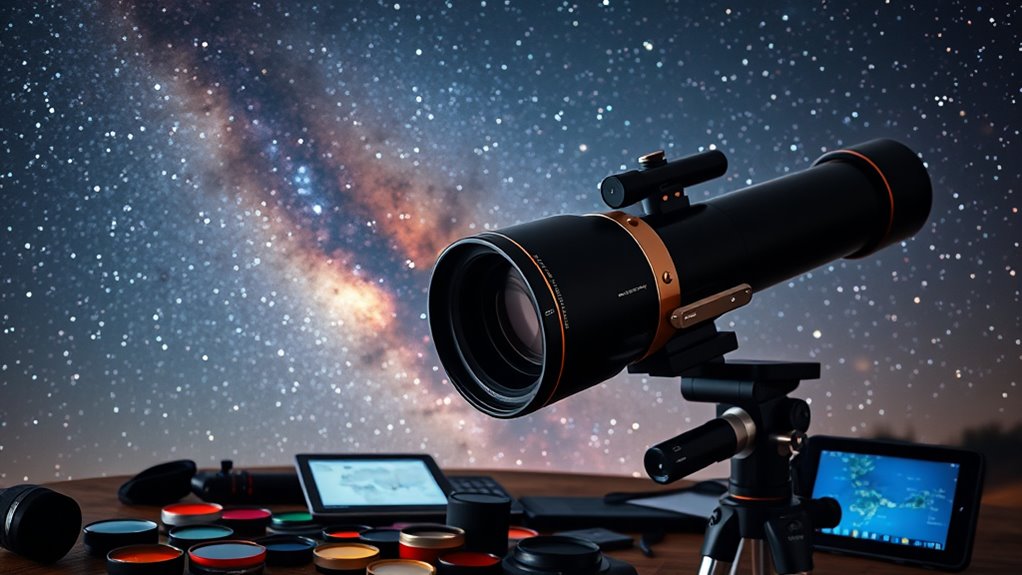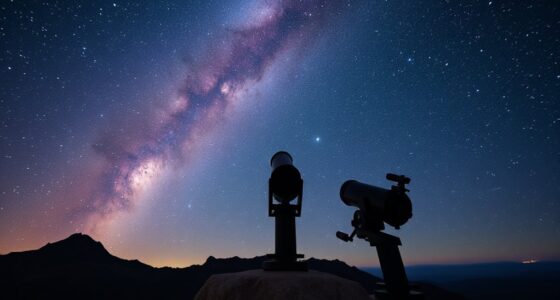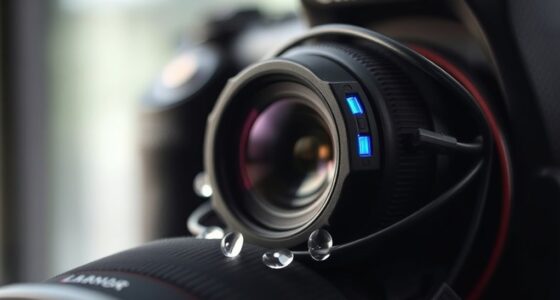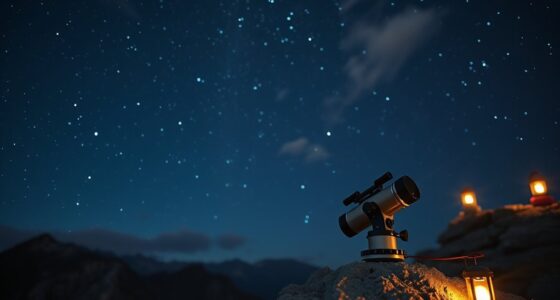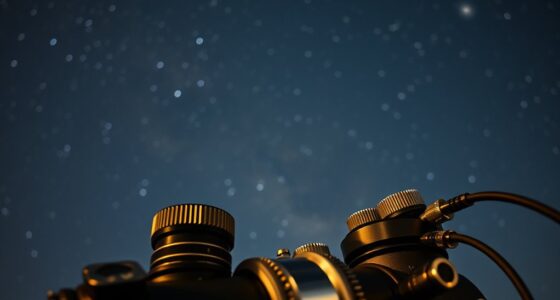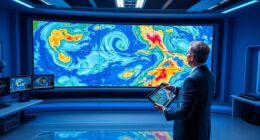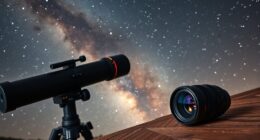If you’re looking for the best APS-C apochromatic refractors for stunning astrophotography in 2025, I recommend checking out models like the Askar 80ED, SVBONY SV503, and Explore Scientific ED102, which offer excellent optics, minimal chromatic aberration, and portability. These refractors provide high contrast and sharpness, ideal for capturing deep-sky objects and planetary details. Keep browsing to discover the top options and find the perfect fit for your astrophotography ambitions.
Key Takeaways
- Prioritize models with ED glass optics and multi-coatings for minimal chromatic aberration and high-contrast, sharp images.
- Consider size, weight, and portability for field astrophotography and ease of setup.
- Check focus mechanisms, such as dual-speed or electronic focusers, for precise sharpness across the field.
- Assess compatibility with accessories like flatteners, adapters, and filters to enhance imaging capabilities.
- Balance optical quality, aperture size, and budget to select the best APSc apochromatic refractor for stunning astrophotos.
Askar 80ED Telescope (80mm F7, 560mm, ED Glass Refractor)

If you’re looking for an astrophotography telescope that combines portability with high-quality optics, the Askar 80ED is an excellent choice. Its 80mm aperture and F7 focal ratio deliver sharp, high-contrast images, perfect for capturing celestial details. The ED glass refractor minimizes chromatic aberration, ensuring clear, vibrant images. Its retractable lens hood reduces stray light, while dual baffles improve image clarity. The dual-speed rack-and-pinion focuser offers precise tuning, and the lightweight design makes it easy to transport. Compatible with various accessories, it’s versatile for both beginner and experienced astrophotographers seeking portability without sacrificing optical quality.
Best For: amateur and experienced astrophotographers seeking a portable, high-quality refractor telescope for detailed celestial imaging.
Pros:
- Sharp, high-contrast images with minimal chromatic aberration thanks to ED glass optics
- Portable and lightweight design for easy transport and setup
- Dual-speed focuser allows precise focusing for astrophotography
Cons:
- May require additional accessories (e.g., reducers, flattener) for optimal imaging results
- Limited aperture size compared to larger telescopes, which may affect deep-sky object brightness
- Retractable lens hood and other features may need careful handling to ensure longevity
SVBONY SV503 Refractor Telescope, 102mm F7

The SVBONY SV503 Refractor Telescope, with its 102mm objective lens and F7 focal ratio, stands out as an excellent choice for amateur astronomers seeking high-quality astrophotography on a budget. Its doublet air-spaced achromatic S-FPL51 ED glass minimizes chromatic aberration, delivering bright, sharp images. The multi-layer coatings boost brightness and resolution, while the retractable dew shield helps prevent dew buildup and stray light. Although not a true APO, the scope exhibits minimal CA, mainly around bright objects like the moon. Its durable build, smooth dual-speed focuser, and portable design make it a versatile, cost-effective option for capturing detailed planetary and deep-sky images.
Best For: amateur astronomers and astrophotographers seeking a high-quality, portable refractor telescope with excellent image clarity on a budget.
Pros:
- Bright, sharp images with minimal chromatic aberration thanks to S-FPL51 ED glass and multi-layer coatings
- Smooth dual-speed focuser with 360-degree rotation for precise framing and focusing
- Portable design weighing approximately 8.69 pounds, ideal for Grab & Go use and astrophotography
Cons:
- Initial focuser backlash that may require minor adjustments
- Not a true apochromatic scope, with slight chromatic aberration around bright objects
- Lacks included storage case, requiring separate purchase for protective transport
SVBONY SV550 Telescope with Triplet Apochromatic, 80mm F6 Refractor Telescope
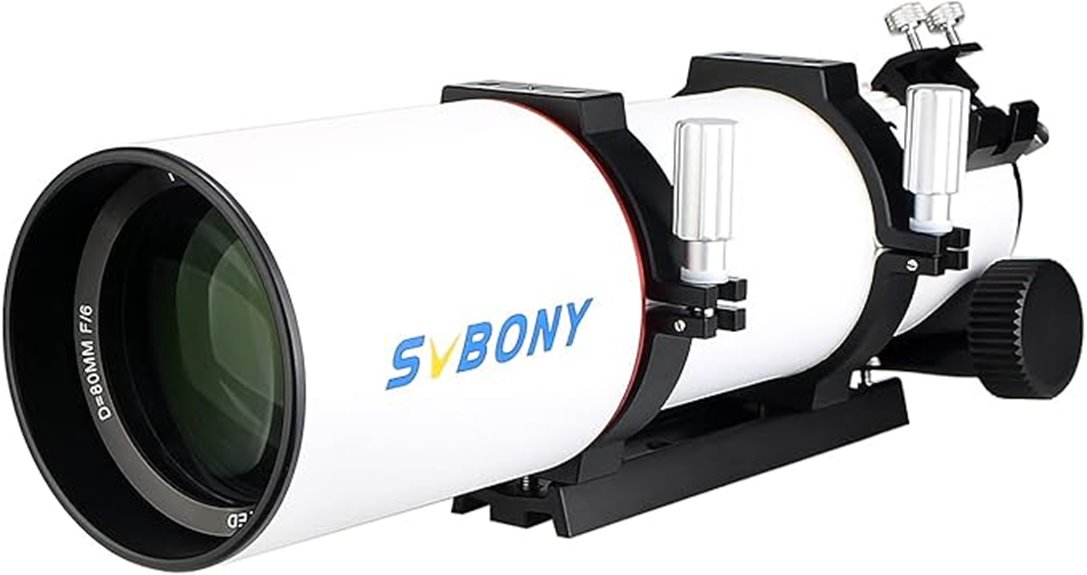
Among the top choices for astrophotographers seeking high-quality images without breaking the bank, the SVBONY SV550 Telescope with its triplet apochromatic design stands out. Its 80mm F6 refractor uses low-dispersion ED glass to eliminate chromatic aberration, delivering bright, sharp, high-contrast images. The air-spaced triple optics produce pinpoint stars across the entire field, ideal for planetary, deep-sky, and astrophotography. Built with durable materials, it features a smooth dual-speed focuser supporting full-frame cameras. Its compact size and lightweight design make it portable. Overall, the SV550 offers excellent value for astrophotographers wanting precision optics and reliable performance at an accessible price point.
Best For: amateur and semi-professional astrophotographers seeking a high-quality, portable refractor telescope with excellent optical performance at an affordable price.
Pros:
- Triplet apochromatic design eliminates chromatic aberration, delivering sharp, high-contrast images.
- Compact and lightweight build for easy transportation and quick setup.
- Supports full-frame cameras with a smooth dual-speed focuser for precise focusing.
Cons:
- Minor dust inside the lens elements may be present, potentially affecting image quality if not cleaned.
- Some users may experience support or accessory compatibility issues from third-party vendors.
- The scope’s aperture limits its ability to gather light compared to larger telescopes, affecting deep-sky imaging in very low-light conditions.
Explore Scientific ED102 Triplet Refractor Telescope

The Explore Scientific ED102 Triplet Refractor Telescope stands out as an excellent choice for astrophotographers seeking high-quality images without breaking the bank. Its 102mm aperture, combined with genuine FCD1 HOYA ED glass and multi-layer coatings, delivers sharp, high-contrast views with minimal chromatic aberration. The air-spaced triplet design ensures stellar edge-to-edge clarity, ideal for capturing nebulae, galaxies, and planetary details. Its 714mm focal length, adjustable with accessories, allows versatile imaging from light-polluted sites. Lightweight and portable, it pairs well with popular mounts, making setup quick and straightforward. Overall, it provides exceptional value, especially considering its performance-to-price ratio around $799.
Best For: amateur astronomers and astrophotographers seeking a portable, high-quality refractor telescope for both visual observation and imaging, especially in light-polluted environments.
Pros:
- Excellent optical quality with minimal chromatic aberration due to FCD1 HOYA ED glass and triplet design
- Versatile focal length of 714mm, adjustable with accessories for various astrophotography needs
- Lightweight and portable, making it easy to transport and set up
Cons:
- Requires additional accessories such as finders, eyepieces, and adapters for full functionality
- Slight star shape distortions may occur due to mounting screw adjustments or collimation issues
- Focuser may have some backlash initially, necessitating tension adjustments or future upgrades
Sky-Watcher Evolux 82ED Refractor Telescope

If you’re seeking a lightweight, affordable refractor that delivers decent optical performance for wide-field astrophotography, the Sky-Watcher Evolux 82ED is worth considering. It features an 82mm ED doublet lens with high-transmission coatings that reduce false color, making it suitable for capturing wide-field images. The scope is compact and lightweight at just 6.5 pounds, ideal for grab-and-go setups. Its build includes a dual-speed focuser, adjustable dew shield, and comes with a foam-lined case. While some users note issues like chromatic aberration and build quality concerns, it offers good visual and astrophotography performance at its price point.
Best For: beginners and casual astrophotographers seeking a lightweight, affordable refractor for wide-field imaging and visual observation.
Pros:
- Compact and lightweight design (6.5 pounds), ideal for portable setups and grab-and-go use
- Good optical performance with sharp stars and minimal false color when used with appropriate accessories
- Comes with useful features like dual-speed focuser, adjustable dew shield, and foam-lined carrying case
Cons:
- Some units may experience manufacturing issues such as stuck focuser rings or chipped paint
- Build quality can feel cheap or lightweight compared to higher-end telescopes
- Chromatic aberration and need for additional accessories (like field flattener) for optimal performance with larger sensors
Explore Scientific ED80 Refractor Telescope for Astrophotography
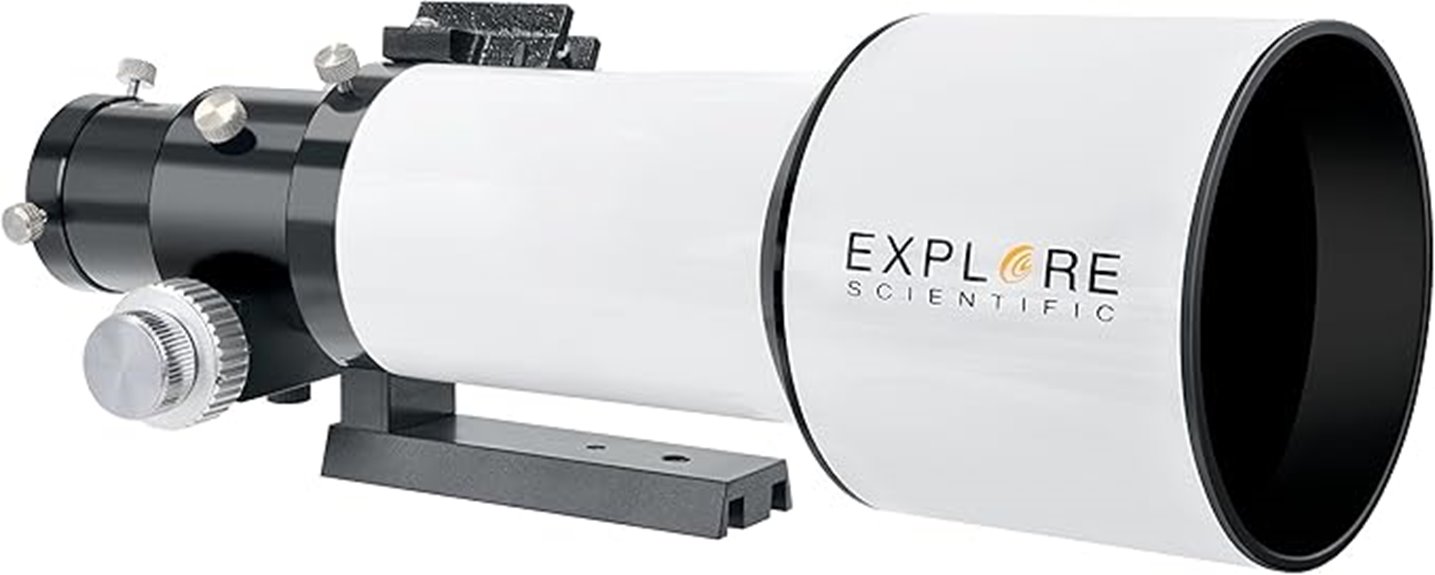
Designed for serious amateur astronomers and astrophotographers, the Explore Scientific ED80 Refractor Telescope stands out with its high-quality optical performance and portability. It delivers sharp, high-contrast images thanks to genuine FCD1 HOYA ED glass and multi-layer coatings, virtually eliminating chromatic aberrations. Its compact 80mm triplet design makes it perfect for on-the-go imaging of the Moon, planets, nebulae, and star clusters. Weighing just under 6 pounds, it’s easy to transport and mount. While some users modify its mount for added stability, its versatile f/6 focal ratio and excellent optics make it a reliable choice for astrophotography enthusiasts.
Best For: amateur astronomers and astrophotographers seeking a portable, high-quality refractor for capturing detailed lunar, planetary, and deep-sky images.
Pros:
- Excellent optical performance with genuine FCD1 HOYA ED glass and multi-layer coatings for sharp, high-contrast images
- Compact and lightweight design weighing under 6 pounds, ideal for portable use and quick setup
- Versatile f/6 focal ratio suitable for a range of astrophotography targets including Moon, planets, nebulae, and star clusters
Cons:
- Mount stability can be improved with modifications like rubber shims or upgraded hardware
- Proprietary finder scope mount may require additional adapters or rings for certain accessories
- Some users report minor manufacturing defects, and the mount’s single screw design can slip without adjustments
SVBONY SV555 Telescope with Precision Focus
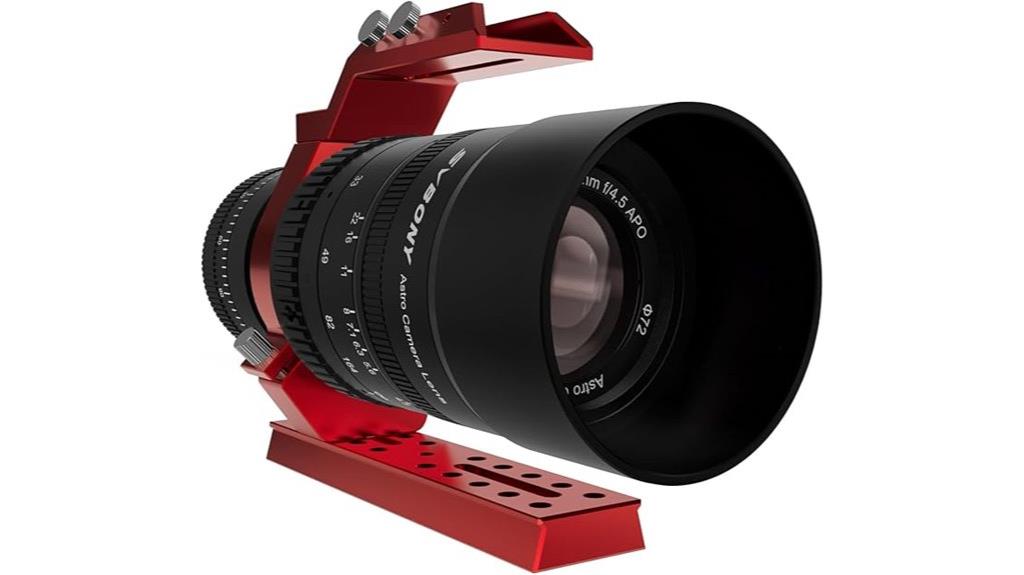
For astrophotographers seeking precise focus and sharp images, the SVBONY SV555 Telescope with Precision Focus stands out as an excellent choice. Its upgraded focus system offers a range from 2.67mm to 3.22mm, ensuring smooth adjustments and zero compromise on clarity. The lightweight design, reduced by 90g, enhances portability, while the optimized lens hood provides full protection. Featuring a 3-group, 5-piece Petzval lens with a triplet, it delivers crisp, high-quality images suitable for various cameras. The easy-to-use fine adjustment and versatile aperture from F22 to F4.5 make it perfect for both quick captures and detailed astrophotography.
Best For: amateur and professional astrophotographers seeking precise focus, high image clarity, and versatile camera compatibility for capturing sharp celestial images.
Pros:
- Upgraded precision focus system ensures smooth adjustments and optimal image clarity
- Lightweight design with a 90g reduction enhances portability and ease of use
- High-quality 3-group, 5-piece Petzval lens with a triplet delivers crisp, detailed images across various cameras
Cons:
- Optional EAF (Electronic Automatic Focus) is not included and must be purchased separately
- Fine adjustment may require some initial familiarization for perfect calibration
- Compatibility with filters limited to two filters due to M48x0.75 filter thread
Celestron StarSense Explorer DX 102AZ Telescope with Smartphone Dock
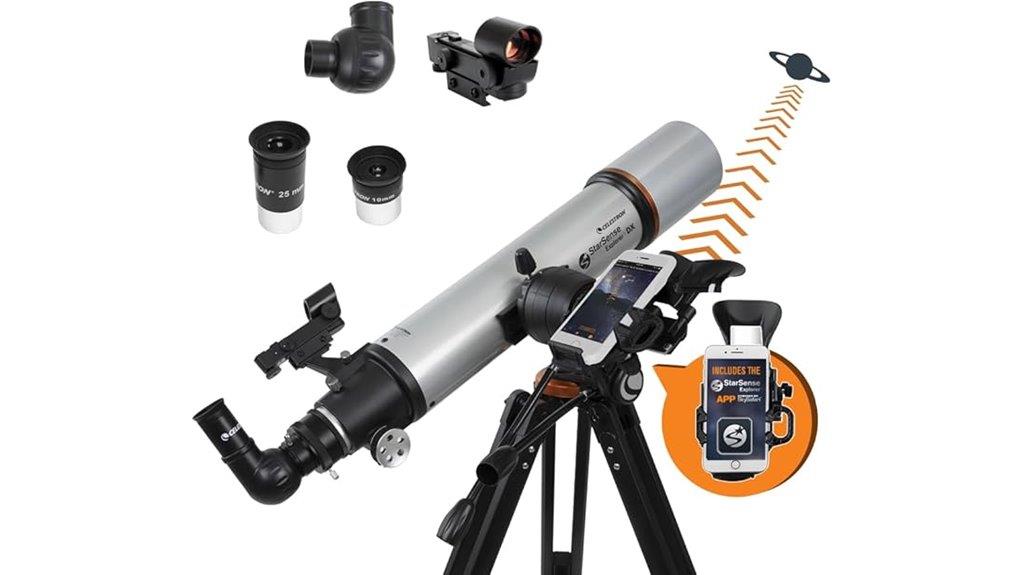
The Celestron StarSense Explorer DX 102AZ Telescope with Smartphone Dock stands out as an excellent choice for beginners and casual astronomers seeking an easy-to-use, tech-savvy setup. It leverages smartphone integration with StarSense’s sky recognition technology and LISA algorithm, guiding you to celestial objects via on-screen arrows. The 102mm refractor offers bright, sharp views of planets, the Moon, and deep-sky objects, even in light-polluted skies. Assembly is quick, and the manual altazimuth mount makes tracking straightforward. Priced at around $399, it combines affordability with solid performance, making it ideal for those starting their stargazing journey and exploring the cosmos with minimal fuss.
Best For: beginners and casual astronomers seeking an easy-to-use, technologically advanced telescope for quick setup and guided celestial viewing.
Pros:
- Smartphone integration with sky recognition technology simplifies object location.
- Bright, sharp optics suitable for viewing planets, the Moon, and deep-sky objects even in light-polluted areas.
- Quick assembly and straightforward manual tracking make it beginner-friendly and convenient.
Cons:
- Photos taken with the phone are over-exposed and blurry, limiting astrophotography quality.
- The scope’s weight and size may be less portable for traveling or outdoor excursions.
- Some users might find the app’s guidance less precise in heavily light-polluted environments or complex sky conditions.
Sky-Watcher EvoStar 80 APO Refractor Telescope
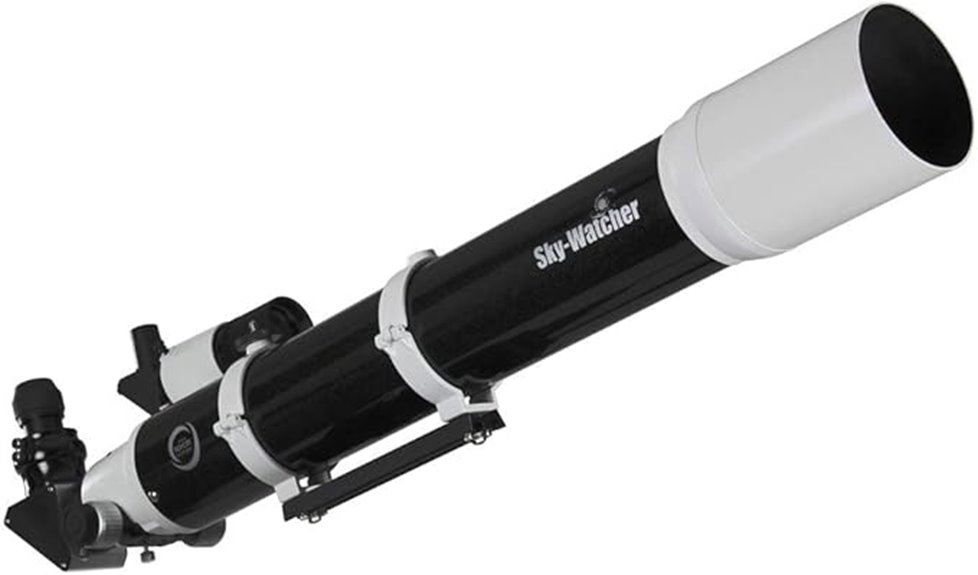
If you’re seeking an affordable yet high-performing apochromatic refractor suitable for both beginner and experienced astronomers, the Sky-Watcher EvoStar 80 APO Refractor Telescope is an excellent choice. It features expertly matched glass, including synthetic fluorite, for superb color correction, making it ideal for visual observing and astrophotography. Its lightweight design, around 7.3 pounds, and compact size ensure portability and ease of use. The scope delivers bright, crisp images of planets, deep-sky objects, and the Moon with minimal chromatic aberration. Complete with a dual-speed focuser, accessories, and a hard case, it’s a versatile, ready-to-go instrument for star parties or backyard sessions.
Best For: amateur astronomers and astrophotographers seeking an affordable, portable, high-quality refractor for visual observation and imaging.
Pros:
- Excellent color correction with expertly matched glass, including synthetic fluorite
- Lightweight and compact design, around 7.3 pounds, ideal for portability and field use
- Comes with a comprehensive set of accessories, including a dual-speed focuser and hard case
Cons:
- Limited aperture size may restrict high-magnification planetary detail compared to larger scopes
- Slightly limited in deep-sky object resolution compared to more advanced or larger telescopes
- May require additional accessories or mounting options for specialized astrophotography setups
Celestron AstroMaster 102AZ Telescope
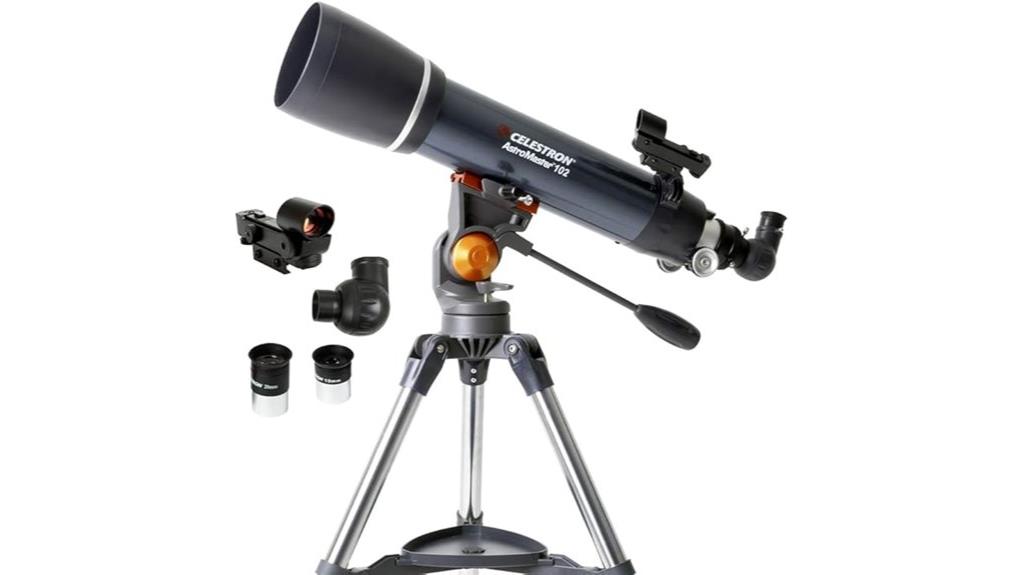
The Celestron AstroMaster 102AZ Telescope stands out as an excellent choice for beginners and casual astronomers seeking a reliable, easy-to-use instrument for daytime and nighttime viewing. Its 102mm fully coated achromatic lens delivers bright, crisp images of the Moon, planets, and star clusters. The refractor design provides right-side-up images, perfect for land-based observations. Weighing around 12.9 pounds, it’s portable and easy to set up, thanks to its tool-free assembly and smooth alt-azimuth mount. The included accessories, like two eyepieces and a finderscope, make target acquisition straightforward. It’s a versatile, budget-friendly telescope ideal for both planetary and terrestrial viewing.
Best For: Beginners, casual astronomers, and those interested in terrestrial viewing who want an easy-to-use, portable telescope with bright, clear images.
Pros:
- Easy to assemble with no tools required, suitable for beginners.
- Bright, sharp images of the Moon, planets, and star clusters thanks to the 102mm fully coated lens.
- Lightweight and portable, making it convenient for transportation and outdoor use.
Cons:
- Tripod stability issues can cause vibrations and difficulty in precise tracking.
- Limited to bright objects; may not perform well with faint deep-sky objects.
- Slightly heavier than some compact models, which may affect long-term portability for some users.
Askar 71F Flat-Field Telescope
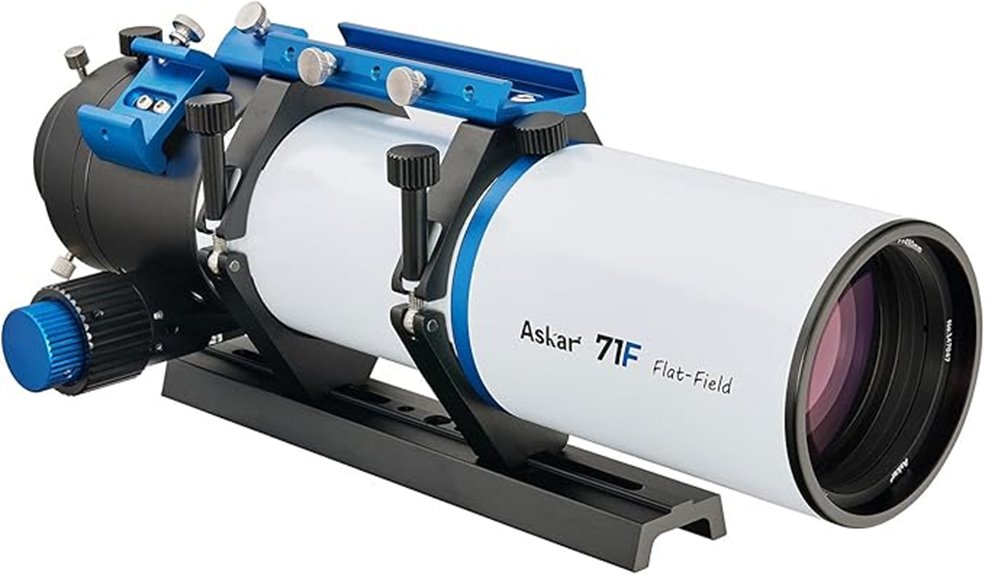
For astrophotographers seeking a portable yet high-quality refractor, the Askar 71F Flat-Field Telescope stands out with its 71mm ED quadruplet optics and flat-field design. It’s lightweight, weighing only 2.5kg, and compact, making it easy to transport and set up. The high-quality CNC construction and matte finish reduce stray light, enhancing image clarity. It’s versatile, suitable for both deep sky astrophotography and visual observation, with included accessories like two eyepieces and an erecting prism. The smooth focus mechanism and 360-degree rotation make framing easy. Overall, this telescope offers impressive optical performance in a portable package, earning high praise from users.
Best For: amateur astrophotographers and visual observers seeking a portable, high-quality refractor for deep sky imaging and general viewing.
Pros:
- Lightweight and compact, easy to transport and set up in various locations.
- High-quality ED quadruplet optics deliver sharp, flat-field images suitable for astrophotography.
- Versatile with included accessories like eyepieces and erecting prism for both imaging and visual observation.
Cons:
- Limited aperture size may restrict deep-sky object brightness compared to larger telescopes.
- Requires additional mounts and accessories for astrophotography to maximize performance.
- Slightly higher price point for a 71mm refractor, which may be a consideration for budget-conscious users.
Omegon Apochromatic Refractor Pro APO AP Photography Scope 72/432 ED OTA
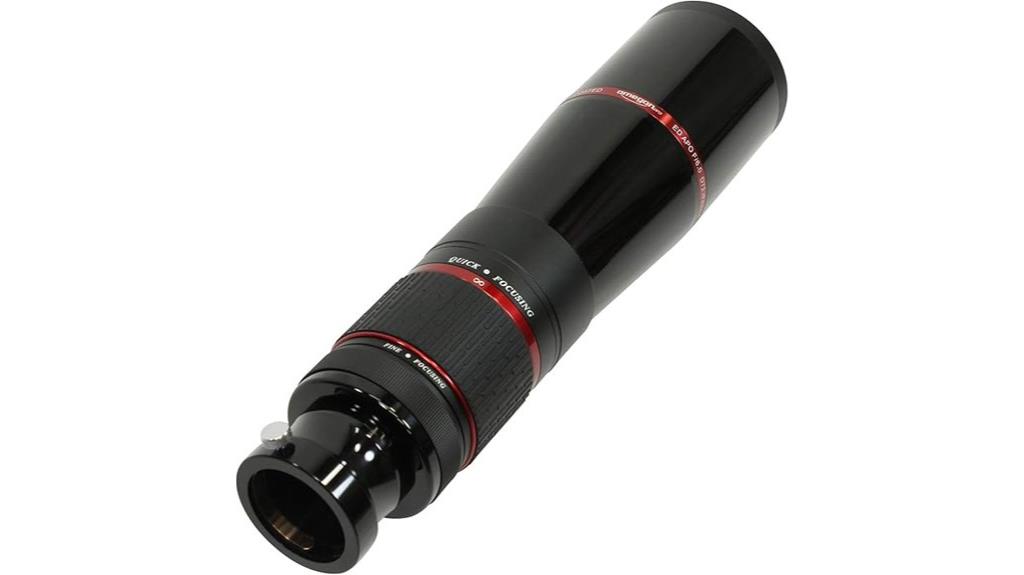
Engineered for versatility and high-quality imaging, the Omegon Apochromatic Refractor Pro APO AP Photography Scope 72/432 ED OTA stands out as an ideal choice for astrophotographers and outdoor enthusiasts alike. It seamlessly combines a telescope, spotting scope, and telephoto lens into one compact, portable instrument. With high-contrast apochromatic optics and a Doublet ED lens, it delivers sharp, detailed images of celestial objects and nature. Its quick-focus mechanism, lightweight design, and compatibility with tripods or mounts make setup effortless. Whether observing stars, birds, or landscapes, this scope offers impressive versatility, making it a valuable tool for travel, astrophotography, and outdoor exploration.
Best For: outdoor enthusiasts, amateur astronomers, and photographers seeking a versatile, high-quality optical instrument for observing and capturing images of celestial objects, wildlife, and landscapes.
Pros:
- Combines telescope, spotting scope, and telephoto lens in one portable device for versatile use
- High-contrast apochromatic optics with Doublet ED lens for sharp, detailed images
- Quick-focus mechanism and lightweight design facilitate easy setup and operation in the field
Cons:
- Limited to a focal length of 432 mm, which may not be suitable for very deep-sky astrophotography
- Weighs approximately 10.34 pounds, potentially requiring sturdy tripods for stability
- May require additional accessories (such as mounts or adapters) for specialized photography or observing needs
Celestron Omni XLT 120 Refractor Telescope
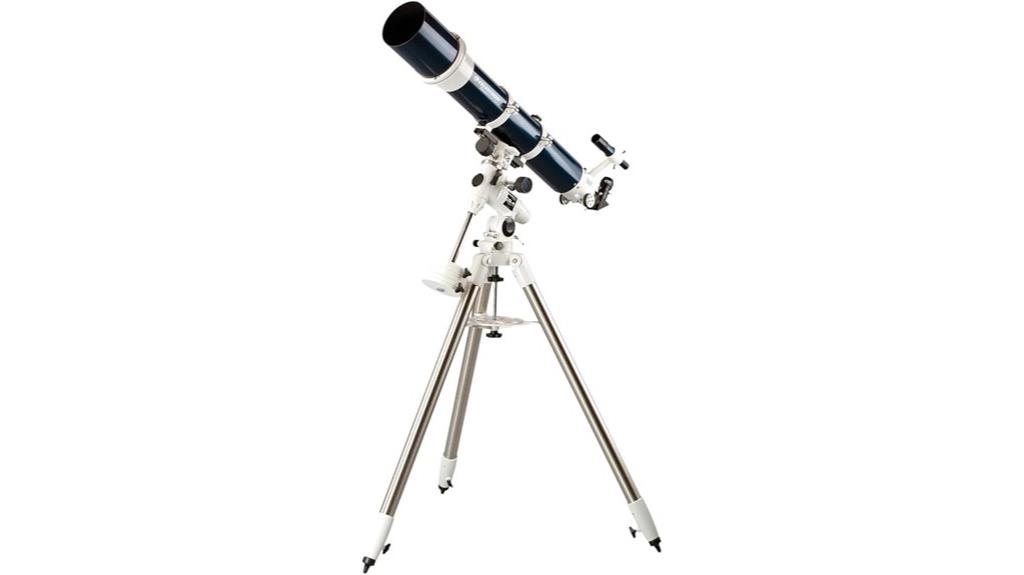
If you’re looking for a reliable refractor that combines high optical quality with user-friendly features, the Celestron Omni XLT 120 is an excellent choice for amateur astronomers and astrophotographers alike. It boasts hand-selected optical glass with fully multi-coated StarBright XLT coatings, delivering bright, sharp images. The high focal length and included 25mm eyepiece provide wide-field views ideal for lunar and planetary observation. Its sturdy Celestron CG-4 German equatorial mount with smooth slow-motion controls ensures precise tracking. While its small aperture limits deep-sky views, it excels at planetary detail. Overall, it offers great value, quick setup, and reliable performance for both beginners and experienced users.
Best For: amateur astronomers and astrophotographers seeking a high-quality refractor with reliable tracking and excellent planetary views.
Pros:
- High optical quality with fully multi-coated StarBright XLT coatings for bright, sharp images
- Sturdy Celestron CG-4 German equatorial mount with smooth slow-motion controls for precise tracking
- Quick setup and portable design make it suitable for both beginners and experienced users
Cons:
- Small aperture limits deep-sky object viewing, especially dim galaxies and faint nebulae
- Overhead viewing can be uncomfortable due to the scope’s length and finder scope orientation
- Customer service issues and logistical problems reported from retailers like Amazon, including incorrect shipments and missing parts
SVBONY SV48P Telescope, 90mm Aperture F5.5 Refractor OTA

The SVBONY SV48P Telescope’s 90mm aperture and F5.5 focal ratio make it an excellent choice for amateur astronomers seeking high-quality astrophotography without the complexity of larger, more expensive scopes. Its fully multilayer green-coated achromatic lens delivers sharp, edge-to-edge clarity while reducing false color. The 2-inch rotatable double-speed focuser offers precise, smooth adjustments, and the all-metal construction ensures durability. With its compact size and lightweight design, it’s easy to set up and transport. It performs well on planetary, lunar, and deep-sky objects, making it a versatile, budget-friendly option for those looking to elevate their astrophotography game.
Best For: amateur astronomers and astrophotographers seeking a portable, high-quality refractor telescope for planetary, lunar, and deep-sky observation on a budget.
Pros:
- Excellent optical clarity with multilayer green-coated achromatic lens for sharp, edge-to-edge images
- Compact, lightweight design for easy setup and transport, ideal for beginners and casual astronomers
- Robust all-metal construction ensures durability and stability during observations
Cons:
- Some users report issues with focuser smoothness and tightness requiring minor adjustments
- Slight chromatic aberration at high magnifications, though minimal and manageable with filters
- Limited accessories included; larger eyepieces or specialized filters may need to be purchased separately
Celestron Advanced VX 6 Refractor Telescope

For amateur astronomers seeking a versatile refractor capable of planetary and lunar imaging, the Celestron Advanced VX 6 Refractor Telescope stands out. Its fully coated lenses provide bright, sharp views with high contrast, ideal for planetary observation. While chromatic aberration is visible, filters help mitigate it. The telescope’s 5 ft 6 in length and weight make transport and setup a bit cumbersome, and the focuser may need upgrades for stability with heavy cameras. The Advanced VX mount offers excellent tracking and GoTo capabilities, supporting astrophotography of bright objects. Overall, it’s a solid choice for serious enthusiasts willing to invest time in setup and tuning.
Best For: amateur astronomers and enthusiasts interested in planetary and lunar imaging who are willing to manage the setup and transport challenges of a large refractor telescope.
Pros:
- Superior fully coated optics deliver bright, sharp, high-contrast views ideal for planetary and lunar observation.
- Advanced VX mount provides excellent tracking, GoTo capabilities, and supports astrophotography of bright objects.
- Built with high-quality materials and features like All-Star Polar Alignment and SkyAlign for precise setup.
Cons:
- The telescope’s length (~5 ft 6 in) and weight (~99.8 pounds) make transportation and setup cumbersome.
- The focuser may require upgrades for stability when using heavy cameras or equipment.
- Chromatic aberration is noticeable, though manageable with filters, and deep-sky imaging capabilities are limited.
Factors to Consider When Choosing an Aps C Apochromatic Refractor
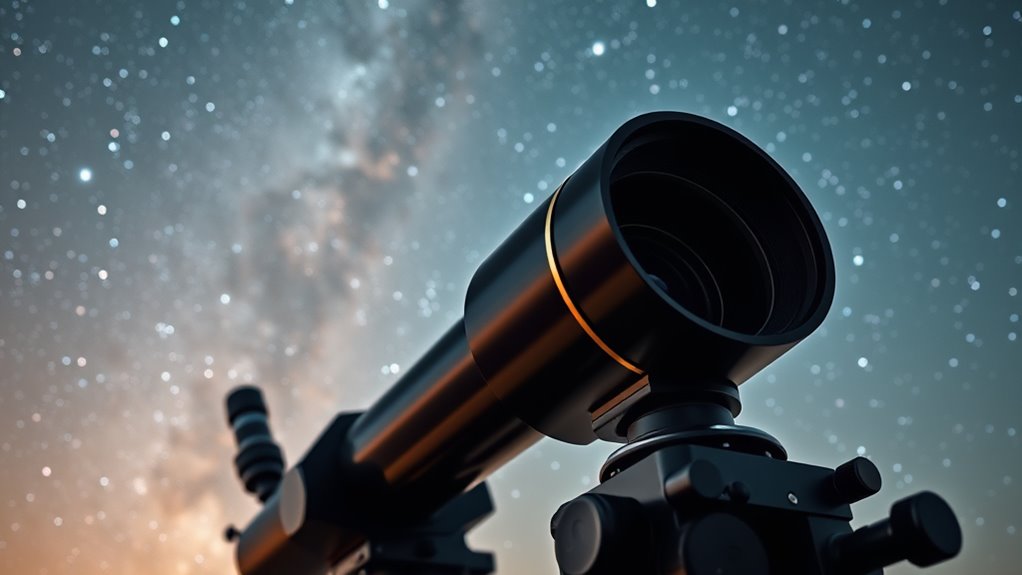
When selecting an APS-C apochromatic refractor, I focus on several key factors that can impact your astrophotography experience. These include optical quality, aperture, build, price, and compatibility with mounts. Considering these points helps guarantee you choose a telescope that meets your needs and budget effectively.
Optical Quality and Glass
Ever wondered what makes an apochromatic refractor stand out in astrophotography? It all comes down to optical quality and the glass used. High-end models utilize special low-dispersion glasses like FPL-51 or FCD1, which drastically cut down chromatic aberration across the visible spectrum. The triplet design, with three carefully matched lens elements, offers superior color correction and sharper images than doublets or achromats. Using ED (Extra Low Dispersion) glass minimizes false color and guarantees true color fidelity, essential for capturing the universe’s vivid details. Multi-layer coatings on lens surfaces boost light transmission, contrast, and reduce reflections, resulting in brighter, clearer images. The precision in optical element manufacturing and proper spacing are key to controlling aberrations and delivering the stellar image quality you need for astrophotography.
Aperture and Focal Length
Choosing the right apochromatic refractor involves understanding how aperture and focal length shape your astrophotography results. A larger aperture lets in more light, producing brighter images and revealing faint objects with better resolution. Focal length, on the other hand, influences magnification and the field of view; longer focal lengths offer higher magnification but narrower views. The focal ratio, derived from dividing focal length by aperture, affects whether your scope suits wide-field imaging or detailed planetary work—lower ratios (f/5-f/6) are ideal for fast, wide views. Striking the right balance between aperture and focal length is essential for capturing the detail, brightness, and specific celestial targets you aim to photograph. Your goals—whether deep-sky, planetary, or landscape astrophotography—will guide your best choice.
Build and Portability
A well-designed APS-C apochromatic refractor combines high-quality optics with a focus on portability, making it easier to take your astrophotography gear on the go. These telescopes are typically compact, constructed with lightweight materials like aluminum or carbon fiber, which helps reduce overall weight without sacrificing durability. The length of the optical tube varies, usually between 14 to 30 inches, influencing how easily it can be transported and stored. Many models feature retractable dew shields and collapsible components, further minimizing size during transport. Using lightweight mounting accessories such as Vixen-style dovetails and sturdy tube rings enhances portability while maintaining stability. Overall, these refractors are designed for convenience, allowing you to set up quickly at different locations without compromising build quality or performance.
Price and Value
Investing in a high-quality APS-C apochromatic refractor can be a significant expense, so understanding its value is essential. Higher-priced models generally offer superior color correction, better build quality, and more advanced features like multi-coated lenses and robust focusers, which enhance their worth for serious astrophotographers. However, not all premium models are necessary for everyone, so weighing the cost against your specific needs is important. Budget-friendly options might have compromises in coatings, materials, or accessories, impacting performance but still providing good value for casual use. Comparing prices across different models helps determine whether the extra investment aligns with your imaging goals, ensuring you get the best balance of performance and affordability for your astrophotography pursuits.
Mount Compatibility
Ensuring your APO refractor is compatible with your mount is crucial for stable and precise astrophotography. First, check that the scope’s mounting system matches your existing mount, such as Vixen-style dovetails or Losmandy plates. The tube ring and dovetail size should align with your mount’s saddle clamp, typically 200mm Vixen or 3-inch Losmandy. Confirm that your mount’s weight capacity can support the refractor plus all accessories, guaranteeing stable tracking. It’s also important to verify if your mount supports the scope’s required orientation and allows for proper balancing and counterweight adjustments. Ultimately, assess the mount’s tracking accuracy and motor drive compatibility to ensure smooth long-exposure imaging. Proper mount compatibility is essential for achieving sharp, detailed astrophotos without frustration.
Additional Accessories Needed
When selecting an APS-C apochromatic refractor, it is important to take into account the accessories that will enhance your imaging capabilities and overall setup. Field flatteners, reducers, or extension tubes are often needed to optimize image quality and achieve the desired focal length with APS-C cameras. A sturdy, high-quality mount and dovetail plate are essential to support the weight and guarantee stability during long exposures. Proper adapters, like T-rings and T-adapters, are necessary to securely connect your camera to the telescope’s focuser. Filters such as UV/IR cut, nebula, or planetary filters can improve contrast and clarity, especially in light-polluted environments. Additional accessories like guide scopes, auto-focusers, and reliable power supplies can considerably improve imaging precision and ease of use.
Frequently Asked Questions
How Does Temperature Affect the Performance of Apochromatic Refractors?
Temperature changes can impact the performance of apochromatic refractors by causing slight expansion or contraction of the glass and metal components. I’ve noticed that colder temperatures may introduce slight optical distortions or misalignments, so I always give my equipment time to acclimate before shooting. Using dew shields and proper heating can also help maintain peak performance, ensuring my images stay sharp and clear regardless of the weather.
What Maintenance Is Required for Optimal Astrophotography Results?
To keep my astrophotography gear in top shape, I regularly clean the lenses with a soft brush and proper lens cleaner, and check for dust or dew buildup. I also make certain the mount is well-aligned and lubricated. Covering my equipment when not in use prevents dust and moisture damage. Periodic collimation and calibration are essential for sharp images, especially after temperature fluctuations. Proper maintenance ensures consistent, stunning astrophotography results.
Can These Telescopes Be Used for Terrestrial Viewing as Well?
Yes, these telescopes are great for terrestrial viewing too. Their high-quality optics provide sharp, clear images of distant land objects, making them versatile for both astronomy and nature observation. I love using mine during daytime to explore landscapes or wildlife. Just remember to switch to appropriate eyepieces for terrestrial use, and you’ll enjoy crisp, detailed views whether you’re gazing at stars or scenic vistas.
How Do Different Glass Types Impact Image Clarity in Apochromatic Refractors?
Different glass types in apochromatic refractors are like various spices in a kitchen, each adding unique flavor to the image. FPL-53, for example, offers exceptional clarity and minimal chromatic aberration, making your images sharp and vibrant. Other glasses like ED or fluorite also reduce color fringing and enhance contrast. Choosing the right glass impacts overall image clarity, especially for astrophotography, where every detail counts.
What Accessories Enhance the Astrophotography Capabilities of These Telescopes?
To boost my astrophotography with these telescopes, I rely on accessories like high-quality camera adapters, sturdy mounts, and tracking systems. I also use narrowband filters to improve image contrast and reduce light pollution. A good dew shield and remote shutter release help me capture clearer shots. Investing in these tools makes a noticeable difference, allowing me to get sharper, more detailed astrophotos with less hassle.
Conclusion
If you’re serious about astrophotography, investing in one of these top 15 APSC apochromatic refractors can truly elevate your images. Did you know that APSC sensors now capture up to 50% more light than standard DSLR sensors? That means brighter, sharper star fields and more detail in every shot. With the right telescope, you’ll be amazed at what you can achieve under the night sky. Happy imaging!
